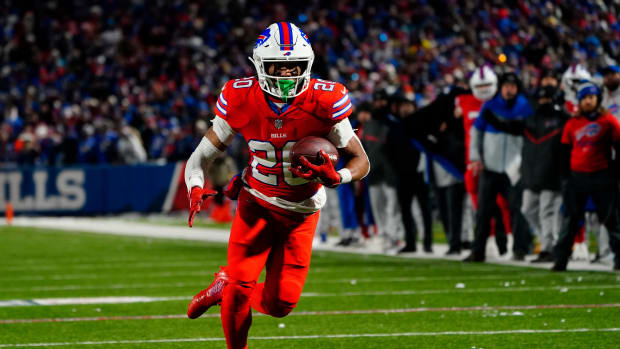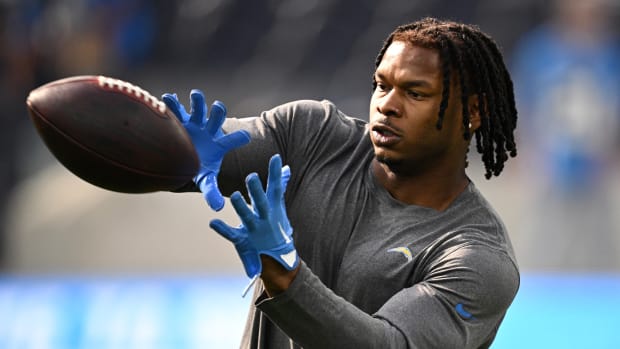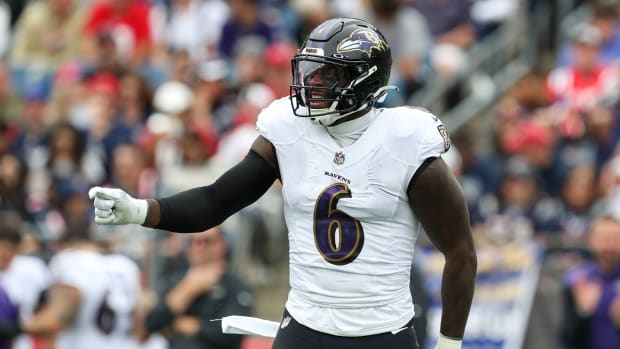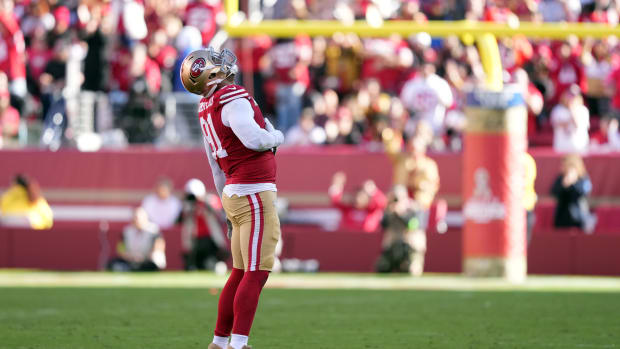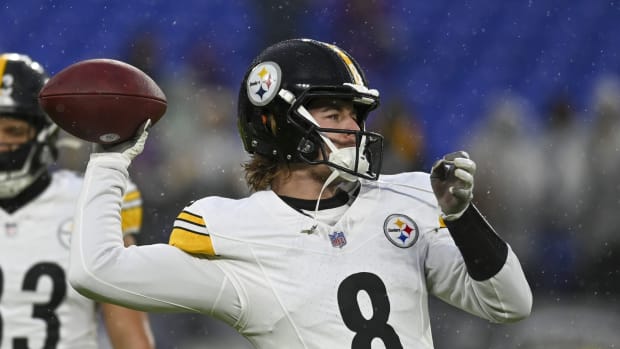
The NFL Has A Major Underclassmen Problem
Fresno State quarterback Derek Carr was one of only a half-dozen—at best—potential first-round prospects at the Senior Bowl, which traditionally is a richer environment for scouts to mine. (Stacy Revere/Getty Images)
MOBILE, Ala. — The cries came from every corner in the NFL world: coaches, personnel executives and agents.
There’s nothing here. ... Worst group I’ve ever seen.
They were talking about the players on display at the Senior Bowl, the premier pre-draft showcase on the field. They weren’t just whistling in Dixie. In the previous five drafts, there were an average of 10.2 Senior Bowl players draft in the first round—and no less than eight (2012). There was an average of 2.2 players taken in the top 15.
Mobile Musings
At the Senior Bowl practices, Greg Bedard found a receiver bonanza, the next Geno Atkins and an absence of elite QBs. FULL STORY
After spending most of the week in Mobile, the consensus is there were maybe three first-round talents here, with a maximum of six.
There is little doubt what is responsible for the drain on the experienced and mature player ascending into the draft: the new collective bargaining agreement that arrived after the 2011 lockout and was first in place for the ’12 draft. After having an average of 50.1 players declare for the draft from ’05 to ’11, the number has basically doubled under the new CBA: from 56 in ’11 to 65 in ’12, 73 in ’13 and 98 this year. As of right now, about 250 players will be selected in the NFL draft. You do the math.
The effects are having wide-ranging impacts on the draft, college football, the evaluation process and the viability of NFL players. Let's address each:
College Football
The reason that there has been such a rise in underclassmen declaring for the draft is because of the rookie wage scale instituted by the owners. All draft picks are now locked into their rookie contracts for at least three years. The impact on the first-round picks is even more punitive since teams hold an option for a fifth year, and then they can be franchised in the sixth. Jason Cole of the National Football Post perfectly laid out the situation.
Ryan Kerrigan (Patrick McDermott/Getty Images)
For a player like Redskins outside linebacker Ryan Kerrigan, who played four years in college, he might not hit unrestricted free agency until he’s 29 and heading into his seventh season. That likely will be his only opportunity for a big-money contract.
That leads players—and the agents and buddies whispering into their ears—to the following thought: Get into the NFL as soon as possible to get that free agency clock started and get to that big money.
The result is that you’re getting more and more players leaving school early, many of whom aren’t ready. “The college programs are having a big problem,” said one prominent NFC general manager who spends a lot of time on the road scouting. “That means the NFL has a big problem. I can only speak for me, but I want guys who have skins on the wall. A lot of these guys don’t have them, and you’re having to project even more.”
College football programs are now taking a page from their basketball counterparts. They’re telling top prospects that they can get them out in three years and using the promise of playing time as freshmen as the biggest selling point.
“College football is turning into the NBA,” said a long-time college scout. “They’re telling the players they can get them in and out. And half of them aren’t ready.”
Expect this to be a big area of discussion when the competition committee meets with top college coaches at the NFL Scouting Combine next month in Indianapolis.
“I don’t know what can be done about it,” said the general manager. “The CBA is the CBA and it’s locked in (until 2021).”
Expect there to be an increase in the education of the college players on life in the NFL, namely that the average length of a career is about 3.5 years. It’s in the player’s best interest to get his college education because, odds are, they won’t be in the league for long.
Evaluation Process
Despite having a good idea about which players will declare early, most NFL teams don’t start studying the underclassmen until after the Senior Bowl. With so many 90-plus underclassmen to research now, several scouts said that they expect to be doing even more research on third-year sophomores and juniors during the season. That could lead to a bit of a mess. The league is vigilant about NFL personnel steering clear of underclassmen out of respect for college football.
In any event, what we now know is the post-season evaluation process—the NFLPA Bowl, East-West Shrine Game and the Senior Bowl—has been adversely affected if not completely broken. The more juniors that declare, the weaker that leaves the senior class the following season. If you thought this year’s Senior Bowl was watered down, wait until next season.
The NFL created this situation with the NFLPA, and both groups need to deal with the ramifications.
“This really screws us up,” said another college scout. “The talent is going downhill at these games.”
One solution that was being talked about in Mobile, which Senior Bowl executive director Phil Savage brought up on NFL Network, is to allow some underclassmen to play in the events.
NFL Players
With more younger players coming into the league, some are going to fall through the cracks, especially those who need more development. There are only 53 roster spots and eight practice squad slots available on each team. There isn’t much room for developmental players. Move this to the top of the list why the NFL needs to revive a developmental league, which ceased to exist when NFL Europa was closed in ’07. The NFL created this situation with the NFLPA, and both groups need to deal with the ramifications. (What fans shouldn’t want is for the NFL to begin to think expansion is the answer. It would water down the product.)
The 2014 Draft
Even though NFL teams have just started their evaluation of the underclassmen, general managers universally believe this will be the deepest draft ever because of the influx.
“You hope that all these guys can play,” said Chiefs general manager John Dorsey. “Once you determine they can play and they're real players, after studying the combine next month, you'll see it. All of a sudden you'll have quality of depth. Hopefully that adds quality of depth to this year's draft.”
The NFL Job Interview
The Senior Bowl is an introduction to pro football, with coaches and scouts quizzing players to see if they're ready. Jenny Vrentas followed three QBs to see how they did. FULL STORY
That could lead to a rash of trade downs—including picking up seventh-round selections to get a jump on undrafted free agency—and teams using picks from the ’15 draft to get more picks this year.
“If people say there are a lot of juniors this year, that means there might not be a lot of seniors next year and teams will say, ‘Let's maybe use future picks for this year,’” said Rams general manager Les Snead. “You never know how that's going to work. But I do think when it's deep, that it does affect strategy. It just depends on how creative people get.”
The Rams could be one of those teams. They have nine selections, including two in the first round: second overall and 13th. St. Louis already stated it’s open to trading down.
“I'm ecstatic about where we're sitting now with the 2 and 13,” Snead said. “The deeper this (draft) gets, all of a sudden you may have more quality. You may have a second and a third that you might feel good about trading to get lower and with more picks. Should be fun.”
The influx of underclassmen to the NFL is in full swing and shows no sign of slowing down. Things are about to change in a big way.
NICKEL PACKAGE
Five takes on recent NFL news...
1. Seahawks over Broncos? My early thought on the Super Bowl: I like the Seahawks. A lot. I always prefer defense over offense in the postseason, and this is a good matchup for Seattle. The cold weather is only going to help. Seattle’s defense can limit Denver’s preferred short passing game, and it’s tough to run against even when playing nickel. While the Broncos are solid against the run, the Seahawks—with Russell Wilson’s legs as a threat—will do some work. Expect some read option. And while Seattle’s passing game is limited, its shot-play philosophy matches up perfectly with Denver’s weak safety play. Wilson won’t miss the shots Tom Brady did in the AFC Championship Game. Wilson is a better deep-ball thrower.
2. Patriots-Dolphins intrigue. Interesting that, after turning down interview opportunities in the past, Patriots director of pro personnel Nick Caserio accepted an opportunity to speak with the Dolphins. Maybe Caserio is just looking for interview experience. Maybe Bill Belichick wants Caserio to gain some intel on an AFC East rival. Maybe Caserio really wants the job calling his own personnel shots. Belichick has been known to overrule his scouting department on occasion in the draft and take his own guys. That has been a source of frustration for some, but Belichick has ultimate power and can do what he wants. For that reason, it’s tough to tell who’s responsible for which draft picks, but Caserio’s good work has shown up in undrafted free agency and street free-agent pickups. Both areas have immensely helped the Patriots.
3. Surprising Browns hire. I'm surprised the Browns hierarchy of Joe Banner, Alec Scheiner and Mike Lombardi hired Bills defensive coordinator Mike Pettine as head coach. After the Rob Chudzinski debacle, this is a momentous decision for that trio—they better have hit a home run or they’re likely done. Pettine, a former Jets defensive coordinator under Rex Ryan, is a little green in that scenario. That being said, it’s a great decision to go with Ryan’s scheme—it’s effectiveness in today’s NFL is proven (Jets, Saints, Chiefs, Bills all utilize it). And those who have worked with Pettine say he’s organized and thorough with a concise message for players. That’s a good place to start.
4. How Rex's defense does it. Speaking of Rex Ryan, I’ve always been amazed at the effectiveness of his scheme despite having so many moving parts, with constantly changing pressure concepts and coverage calls. I asked him in Mobile how he does that. “It’s all about concepts,” he said. “If you teach the concepts well, the players will understand it. Once they know the concepts, then it’s easy for them to execute. It looks complicated, but it really isn’t.”
5. About that Welker-Talib hit... Belichick knows better than anybody that collisions like that between Wes Welker and Aqib Talib happen in just about every game each week, and his team uses the same tactics. Talib should have known a rub route was coming, but for some reason he didn’t see it. Welker expected, like all receivers in that position, that the cornerback would bubble over the receiver, so he angled toward the line of scrimmage to avoid a hit, not to take Talib out. But Talib didn’t see it, and they collided. Belichick was right that Welker wasn’t making an attempt to get open at that point. But Welker would have looked for the ball in the next window if Talib avoided him. It was a run-of-the-mill, common football play. No more, no less.



































